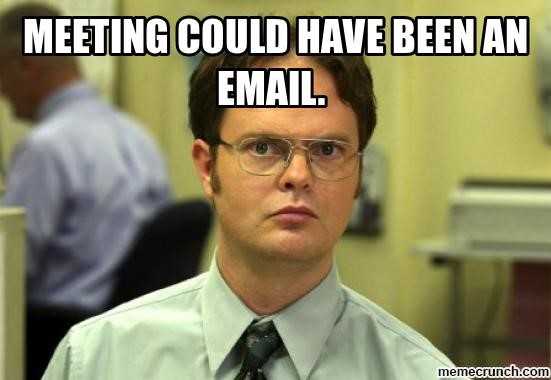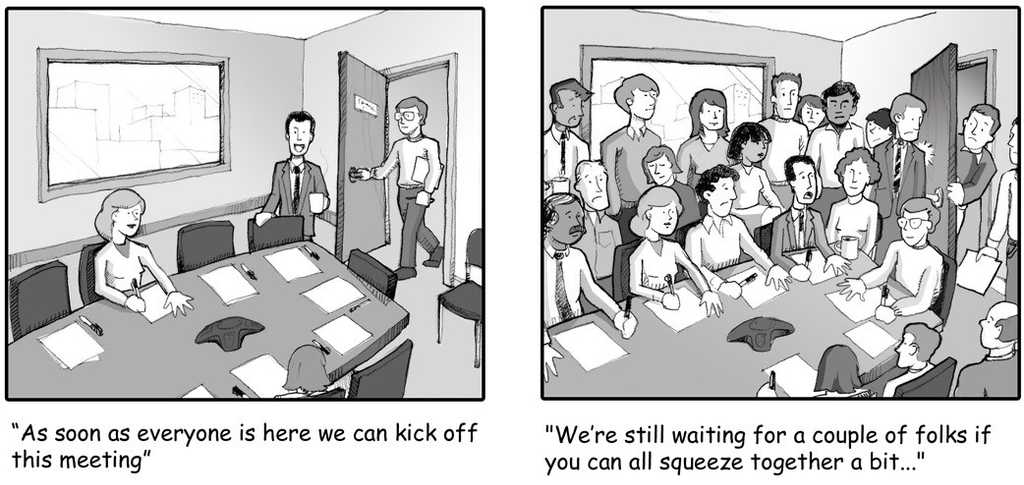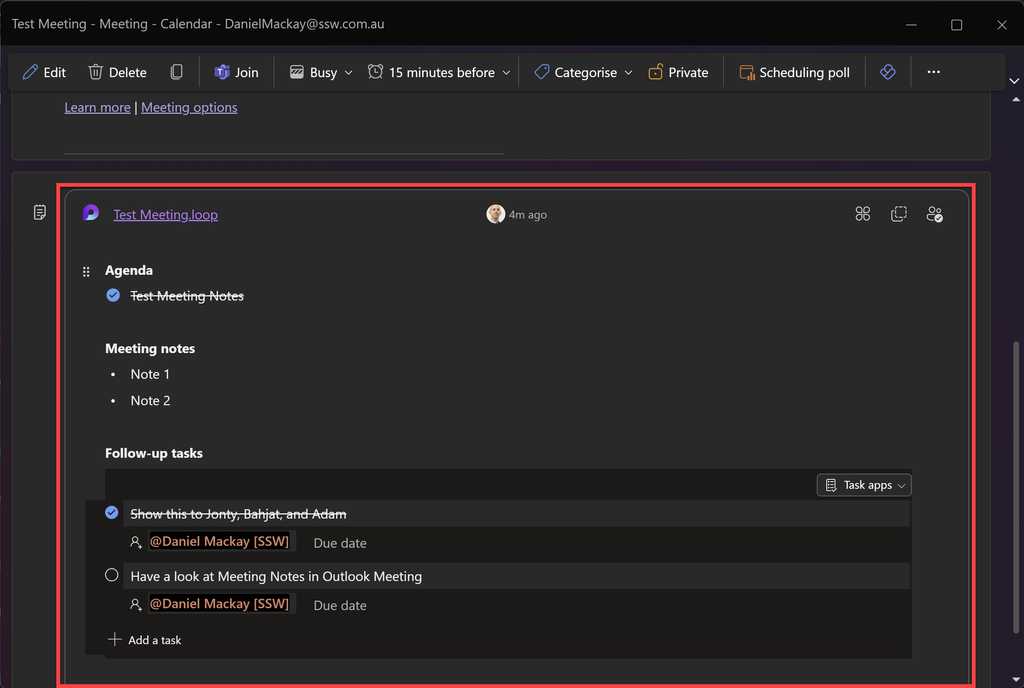Rules to Better Meetings - 13 Rules
Meetings that lack efficiency frequently occur because:
- People are not prepared
- There is a lot of discussion but no resulting "action items"
- Rat holes - Time is wasted digressing to unrelated topics
- People forget the meeting is on and do not attend
- People turn up late with no notice
- Meetings go well overtime
If you have a 1-hour meeting with 5 people in attendance, you're not just wasting 1 hour if it's not productive, your wasting 5 man hours. One hour for each attendee. That's a lot of man hours!
With this in mind, here are some rules on how to facilitate a great meeting and how to make sure they are productive and achieve an outcome.
Meetings are awesome to brainstorm ideas and get in-sync. For some topics they are way more effective than typing on a group chat. There are a few benefits that meetings have, which make them useful to have (for the appropriate topics/reasons).
- In the simplest and most basic way, a meeting defines the team, the group, or the unit. Those present belong to it; those absent do not
- A meeting is the place where the group revises, updates, and adds to what it knows as a group
- A meeting helps every individual understand both the collective aim of the group and the way in which their own work and everyone else’s work, can contribute to the group’s success
- If a back and forth is likely for the topics on the agenda, a meeting may be the best way to let everyone have their say, so the group can align on a shared commitment to a course of action
However, a meeting is an expensive thing, as the operational cost of a 1 hour meeting with 5 attendees is not 1 hour. It is at least 5 hours, plus the time it takes everyone to get back into the zone after the interruption to their usual workflow.
Therefore, only schedule a meeting if the purpose couldn’t have instead been achieved via an email or a group chat (e.g. Microsoft Teams).
Bloating a meeting with unnecessary numbers is the #1 way that a meeting can be doomed... before it starts. Any meeting with more than 10 people is destined to have people attend but who do not participate or contribute. Aim to keep it to 6 or fewer.
A few ways to do this are to:
- Analyse the agenda to see whether everyone has to be present for every item (it may be possible to structure the agenda so that some people can leave at half time and others can arrive)
- Split it into two separate, smaller meetings rather than one big one
- Determine whether one or two groups can be asked to resolve some of the topics in advance, so that only one of them needs to attend with the resolutions
Meetings can be good for the few and unproductive for the many.
A meeting can be useful if it meets these three criteria:
- You know what you're going to do in it
- You do the thing
- At the end, somebody emails the summary and action items out:
‘OK, we’re all going to do these things going forward.’
Scheduling meetings can often feel like a necessary chore, especially when they lack a clear purpose or agenda. Calls or video meetings, without any clear agenda or purpose, are where your joy and energy go to die.
Here’s how to ensure your meetings are effective and worthwhile. Before a meeting, to give it the best chance of success, you should make sure you have done the following:
-
Create a meeting agenda prior to the meeting
- Give each attendee a copy (usually in the appointment)
- If the discussion strays from the topic, everyone should use the agenda to help keep it on track
- Possibly mark items on the agenda as “For information,” “For discussion,” or “For decision”
- Don't add unnecessary agenda items. You won't have time in the future. If you wouldn’t want to do the thing tomorrow, don’t say yes to doing it a month from now
- Send an appointment to all meeting attendees to ensure the meeting appears on their calendar
- The meeting starts the minute the invite is sent, not when it physically starts That means read the agenda and prepare. For example if feedback is needed on a large document, give people the link to the document + give advanced warning that their feedback on the document will be taken ahead of time
- Make sure all the presentation setup is working E.g. Have 'AV Setup meetings'.
- For attendees, if you are going to be late, contact the organizer or the person in charge of the meeting to let them know that you are running late and what time you will be arriving.
Required Attendees: Scrum Team Optional Attendees: Interested Stakeholders Recurrence: Every {{ NUMBER OF WEEKS IN THE SPRINT }} weeks Subject: {{ PROJECT NAME }} – Sprint Review, Retro and Planning Hi Team 👋
This is a calendar appointment to hold the following 3 Scrum meetings:
Sprint Review Meeting We will go through the user stories that have been completed and demonstrate them. See rule What happens at a Sprint Review Meeting?
Sprint Retrospective Meeting Sprint closed and new Sprint starts. We ask for feedback of the previous Sprint so that we can ‘Inspect and Adapt’. See rule What happens at a Sprint Retrospective Meeting?
Sprint Planning Meeting We go through the backlog (aka to-do list), get more information, estimate and then prioritize. We then breakdown to tasks and commit to what we believe we can deliver for the next Sprint. See the rule What happens at a Sprint Planning Meeting?
Regards,
{{ SCRUM MASTER }}<This email is as per https://www.ssw.com.au/rules/scrum-master-do-you-schedule-the-3-meetings>
Figure: Good example - Appointment template for Scrum meetings
-
Anchoring is a cognitive bias where an initial piece of information (the "anchor") heavily influences subsequent judgments and decisions. This bias can infiltrate various aspects of our lives, including workplace interactions and negotiations. Recognizing how anchoring works is crucial to making informed and unbiased decisions. Custom software is difficult to estimate and using an anchor too early or without the necessary rigour can create issues.
For example, in meetings, it's vital to be aware of anchoring, as the first opinions can shape entire discussions. Seniors and experts can influence a meeting's direction and create anchoring effects; therefore, they should offer their ideas last.
Video: Jeff Bezos: Truth is uncomfortable | Lex Fridman Podcast Clips (6 min)Negative impacts of anchoring
An anchor can limit adaptability, making it harder to find mutually agreeable solutions. For instance, a developer’s best guess on a project budget might discourage the client from choosing your solution looking for other options that could be better suited and more cost-effective.
Key reasons to avoid providing an anchor
- Limited information: Early estimates often lack the detailed requirements and complexity analysis needed for an accurate price. Setting an anchor prematurely creates a false sense of precision and sets unrealistic expectations
- Loss of flexibility: A strong initial anchor can stifle negotiation and make it harder to adapt your proposal as more information becomes available. This can hurt your ability to arrive at a price that's fair for both you and the client
- Damaged trust: If the final estimate varies significantly from the initial anchor, it can erode the client's trust in your process. Transparency and an open discussion of uncertainties upfront are key to building a strong client relationship
How to deal with anchoring
Sales need to establish the client’s anchor, if they have one, by asking:
- "Can you describe the process you need improved and its main challenges?"
- "How does this issue impact productivity or costs?"
- "What's your decision-making process and who's involved?"
- "What's your timeline and budget for a solution?"
When asked for an early estimate on a new project, a developer might say "I reckon it'll cost around $50,000". This off-the-cuff estimate sets an unverified anchor that might restrict further discussion and lead to budget constraints based on a premature guess.
Figure: Bad example - Premature estimation without due diligence can lead to inaccurate budgeting and client expectations
Conversely, when asked for an early estimate, a more experienced developer might respond, "To give you an accurate estimate, we should conduct a Specification Review where we can consider all aspects of the project. This way, we can provide a detailed and reliable estimate that reflects the project's complexity".
Figure: Good example - Suggesting a Spec Review ensures that any estimates provided are well-informed and considered
Key Takeaways
- Be aware of how anchoring bias can influence decisions, both within yourself and others
- Proactively seek diverse perspectives to mitigate the bias
- Approach initial information critically, even if it seems compelling, to avoid getting overly 'anchored' in one viewpoint
- Use anchoring strategically for setting expectations or initiating negotiations, but be prepared to adjust as needed
Clients often have an implicit budget or value anchor in their minds when discussing projects. This anchor can be based on a budget set by their business or a perceived value. If you don't uncover this anchor early, it can lead to misaligned expectations and project dissatisfaction.
Understand the Client's Perspective
Clients might not always communicate their budget or value expectations openly. It's crucial to ask the right questions to uncover these hidden anchors.
- Ask direct questions: Questions like "Do you have a budget range in mind for this project?" or "What value do you expect this project to deliver?" can prompt clients to reveal their anchors.
- Understand their constraints: Discussing their financial constraints and priorities helps in understanding the flexibility of their budget.
- Look for cues: Pay attention to any indirect hints about their budget or value expectations during conversations.
Common Types of Anchors
Clients typically come to meetings with one or more of the following types of anchors:
Budget Set by the Business
Often, clients have a budget set by the board or a financial decision-maker within their business. This budget is closely linked to the problem being solved.
Example: If the problem is driving to the shop, but the only solution presented is buying a Lamborghini, and the client doesn't have the funds, this high cost will act as an anchor preventing the purchase.
Experience-Based Anchor
Clients might have previous experience with software or services that set their expectations. These experiences create a benchmark in their minds.
Example: A client who has previously developed software with a specific budget might use that experience as a reference point for current projects.
Techniques to Uncover Hidden Anchors
Using the right techniques can make it easier to identify the client's budget or value anchor.
Direct Inquiry
Directly ask about the budget in a professional manner. This can clear any ambiguities from the start.Be careful, often clients think revealing this can limit negotiations and that if a budget is revealed this will create its own anchor. Clients will either avoid or be misleading within this approach.::: greybox"Can you share your budget limitations for this project so we can tailor our proposal accordingly?":::::: goodFigure: Good example - Directly asking for the budget range:::
Comparative Questions
Ask questions that compare their project with similar past projects.::: greybox"How does this project compare in scope and budget to others you've done recently?":::::: goodFigure: Good example - Comparing with past projects to gauge budget:::
Value-Oriented Questions
Focus on what the client values most in the project. This can often reveal their budget priorities.::: greybox"What are the most important outcomes you expect from this project?":::::: goodFigure: Good example - Asking about expected outcomes to understand budget priorities:::
Indirect Inquiry Techniques
Directly asking a client for their budget is not always effective. There's a fair bit of gamesmanship in sales, and clients may not always be truthful about their budgets and expectations. In these cases, use indirect inquiry techniques to uncover the hidden anchor.
Estimating Size and Value
Clients are less likely to give deceptive answers about the size and value of the problem being solved.
"Can you describe the impact this project will have on your business if successful?"
Figure: Good example - Asking about the impact of the project to gauge its value
Scenario-Based Questions
Ask scenario-based questions to understand their priorities without directly discussing money.
"If this project could only address one major issue, which one would be the most valuable to solve?"
Figure: Good example - Scenario-based question to identify priorities
Historical Comparisons
Clients can provide insights based on their past experiences without directly revealing their budget.
"Can you tell me about a similar project you've done and the key factors that influenced its success?"
Figure: Good example - Asking about past projects to understand budget and expectations
Intelligent Inquiry Based on Client Size
The approach to uncovering hidden anchors should vary depending on the size of the client.
Large Multinational Companies
For large clients, the problems they face and their budgets are typically substantial. However, direct questions about budget can still be met with resistance or deceptive answers. Focus on understanding the scope and impact of the problem.
"For a company of your size, what scale of solution are you envisioning to solve this issue?"
Figure: Good example - Understanding the scale of the solution for a large company
Small Businesses
Small businesses often have strict budget constraints. Directly asking about their budget might make them self-conscious. Instead, discuss the size of the problem and practical constraints.
"What are the key areas where you need the most help within your current budget constraints?"
Figure: Good example - Addressing budget constraints without direct inquiry
Aligning Expectations
Once the hidden anchor is uncovered, align the project scope and deliverables with the client's budget and expectations.
- Set realistic expectations: Clearly communicate what can be achieved within the budget.
- Adjust the scope if necessary: If the client's budget is lower than required, discuss possible adjustments to the project scope to fit their budget.
- Provide value-based proposals: Offer different options that provide varying levels of value and cost, helping clients choose the best fit for their needs and budget.
Conclusion
Uncovering the hidden anchor with clients ensures that both parties are on the same page regarding budget and expectations, leading to a successful project outcome. By asking the right questions and aligning project goals, you can avoid misunderstandings and deliver value effectively.
Any good meeting has a clear goal, and an agenda that breaks that goal up into items that are “For information,” “For discussion,” or “For decision”.
A few other ways to make the most of the attendees' time would be:
- The early part of a meeting tends to be more lively and creative than the end of it, so if an item needs mental energy, bright ideas, and clear heads, put it high up on the list
- Start with the low hanging fruit so you get some decisions made
- Keep the important topics closer to the front, than the end
- Some items unite the meeting while others divide the members. The leader may want to start with unity before entering into division, or they may prefer the other way around. The point is to be aware of the choice and to make it consciously. It is always a good idea to end the meeting on a unifying item
- Don't get side-tracked for too long by urgent, but not important, items. Keep non-important topics timeboxed
- If your meeting is more than an hour or two, consider adding a break
- To improve future meetings, at the end of the meeting, do a quick debrief (aka Retro) to see how long the meeting took, if anything was covered that didn't need to be, etc.
The aim of most meetings should be to come up with next steps. These should be shared with the intended recipient, as well as CCing all other attendees.
It is a good idea to have a scribe who is drafting the action points during the meeting and assigning them directly to those responsible for completing the tasks. If it's not already clear who the scribe is, say "Who will be the scribe?" at the beginning of any meeting. And now in Microsoft Teams, when in a meeting, the scribe can use the Notes tab to add details and list follow-up tasks during the meeting.
The meeting organiser should allow time after the meeting to check the action points before their next meeting. This can seen as a summary page at the end of the meeting.
The scribe should also document the decision-making process by writing down each person's arguments. After everyone comments on the options, the notes can be reviewed as a group and often the best course of action is clear.
Common action items include:
- The outcomes from agenda points marked as “for decision”
- Off topics that require more discussion by subsets of the meeting’s attendees – aka a “parking lot”
- Ad hoc tasks that come up from brainstorming, usually sent as separate email tasks or created as PBIs in a backlog
- A date scheduled for the next meeting (if needed)
As businesses become larger and more complex, it's harder for the decision makers to keep up to date with every product change or be in every meeting. Responsibilities for decision making cannot be delegated but gathering the information to make an informed decision can.
One common tactic is to have a delegate attend the meeting on their behalf and then loop them in at the end, bringing them up to date with an executive summary.
Here are some tips to doing this effectively:
-
Ensure the meeting has an agenda
- It should list the delegate (who is receiving the information)
- The last 5 minutes of the meeting will be used to loop in someone else
- Take notes during the meeting
- Summarize the info/action items with the other people on the call
- Call up the person you want to loop in
-
Loop them in (done by the delegate)
- Lead with the main message and action items. For example, "We need to adjust X in product Y" or "We should look into using X on the next project"
- Include a recommendation where possible
- Group information around the most important themes
- Consider it an executive summary - if you have to recite the meeting, then it isn't a summary. If everything is important, then nothing is important.
- If the delegate says something incorrect the other attendees of the meeting have a chance to correct them
With this strategy, the decision maker can get to the important points quickly. They can be told:
- What's important
- Why they should care
- What action needs to be taken
- What are the choices
- What decisions have to be made and when
- What is your position - don't leave out the recommendation
Tip: If you can't add them to the summary, record a summary and send them a link to watch when they have time.
They know that there is a lot more detail behind what appears to be a one-line summary. If they want more detail, they can drill down or ask for more information.
-
Keeping to your meeting’s timebox shows that you respect your attendees, and allows for you and them to be efficient and able to plan their days effectively. One meeting going over by 30 minutes can have knock on effects for the rest of the day, and a culture of this will create that feeling of “meeting dread” that can be so common.
Always start your meetings on time. Especially for meetings that are regular, as it will teach your attendees that they need to be there from the start, and they will not be waited for.
You can (and should) still have a few minutes of informal conversation at the beginning and end of each meeting, but don’t let it get out of hand.
Announce your arrival
To help get the meeting started on time, you should let other attendees know that you have arrived/joined.
In a Teams meeting, at the scheduled start time you can use the "Request to Join" button in teams.
Go to Meeting | Participants | Request to Join
If the meeting is in person (e.g. at a cafe), you should let other attendees know when you have arrived. Send a Teams message or SMS, e.g.
“I’m here, 10 minutes early. No stress, see you soon.”
Make sure that you cover as much of the agenda as possible within the timebox, and keep other topics to a minimum.
When you identify topics that do need to be hashed out, but are off topic and don't need to be covered in this meeting, keep track of them in a “Parking Lot”.
E.g. During the meeting you can call out “Off topic. I think that topic should be saved for the “Parking Lot”. Who is interested in joining that?”
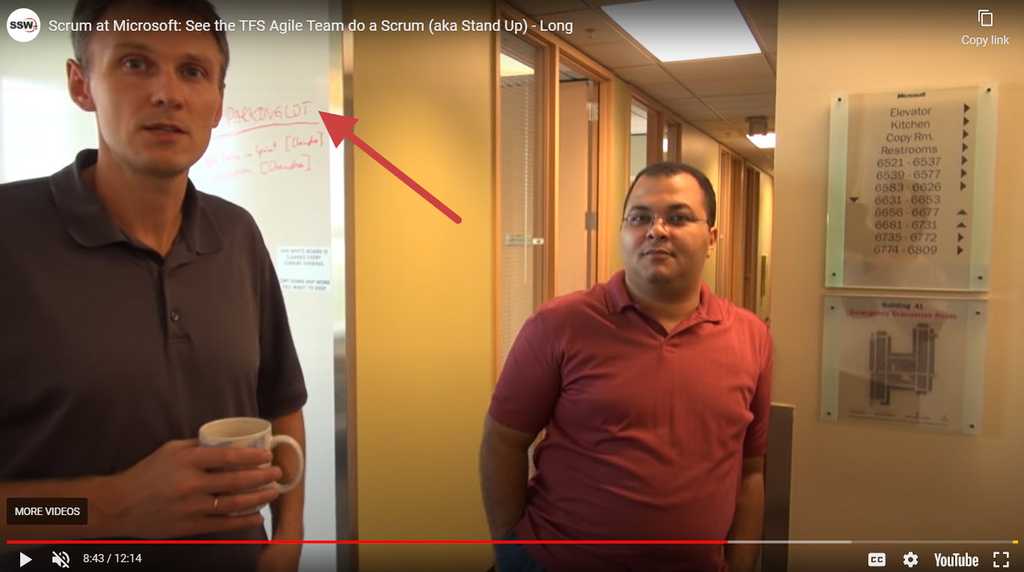
Figure: Video screenshot - The Parking Lot in action See it in the video at around 9:00
It can be difficult to get everybody into a meeting, especially these days when many meetings are online. It is important that time is not wasted in these situations, so it's good to be proactive and have a plan for when the decision maker is busy.
Make it a ceremony
You have already shared the agenda, so pick out the best item and ping the decision maker on teams before the meeting:
"We're meeting in 30 minutes, I'm excited to be talking about xxx"
Be persistent
If the meeting has started and someone is missing, then add them to the call. Ping them if they dont answer. If a decision maker is missing from the call and you don't get a response, tell them "I will call you towards the end of the meeting for a summary", as per Do you know how to loop someone in at the end of a meeting?
Once you have done the above, you can start the meeting without the decision-maker. You may choose to start with the less important items in the agenda, or the ones that won't require a final decision ("For information" items) that can be easily summarised at the end of the meeting.
I’m here, where is everyone else?
If you join a meeting and the other attendees haven't joined yet, use the ”Request to Join” button in teams.
Teams | Participants | Request to Join
This will remind the team that the meeting has started just in case they missed the calendar reminder.
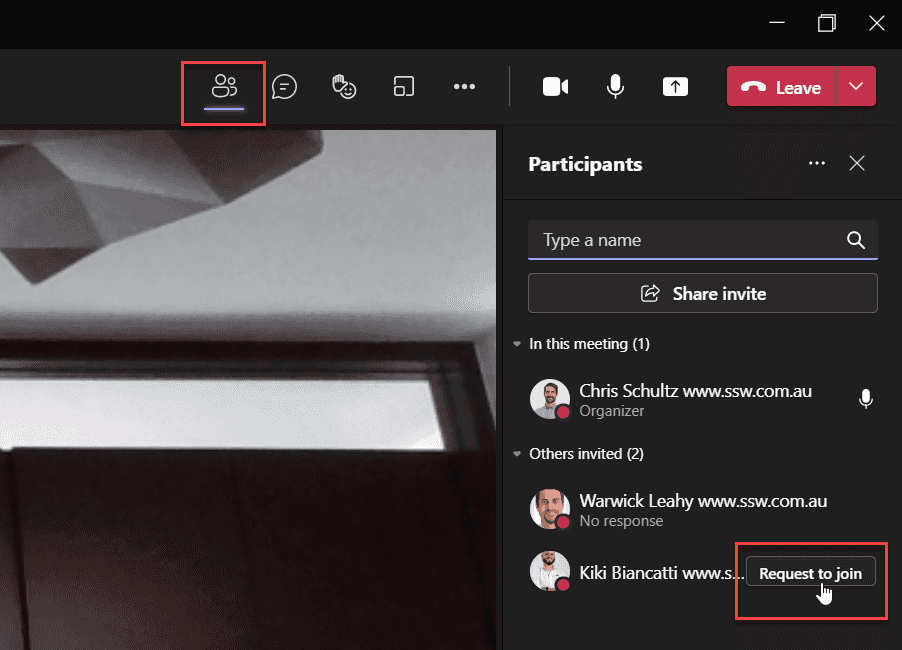
Figure: In Microsoft Teams, add someone to the call by Show Participants | Request to join Microsoft Teams makes it super easy to record meetings, whenever you are presenting something important or making impactful decisions, the meeting scribe should 'hit record'.
Before recording, let the attendees know that the meeting will be recorded (Teams has a popup that does this automatically).
Why record meetings?
- Document decisions - If design decisions are made in a meeting, having a record means you can go back and check what was said.
- Easy to Share - You can send YouTube links to clients or distribute internally
- Training Material - Use the recordings for onboarding or as case studies
- Post-Meeting Analysis - Review to make your next meeting even better
- Remote Inclusion - Helps remote or absent team members stay in the loop (Its always better if they can attend)
Storing recordings
When you record meetings in Teams, they are stored in Microsoft Stream. Microsoft Stream will delete recordings, so ensure the meeting scribe downloads the recording and uploads it to YouTube.
After recording find the link to the recording in the meeting chat
- Click the 'Copy to' button and move the file to a relevant Team's channel
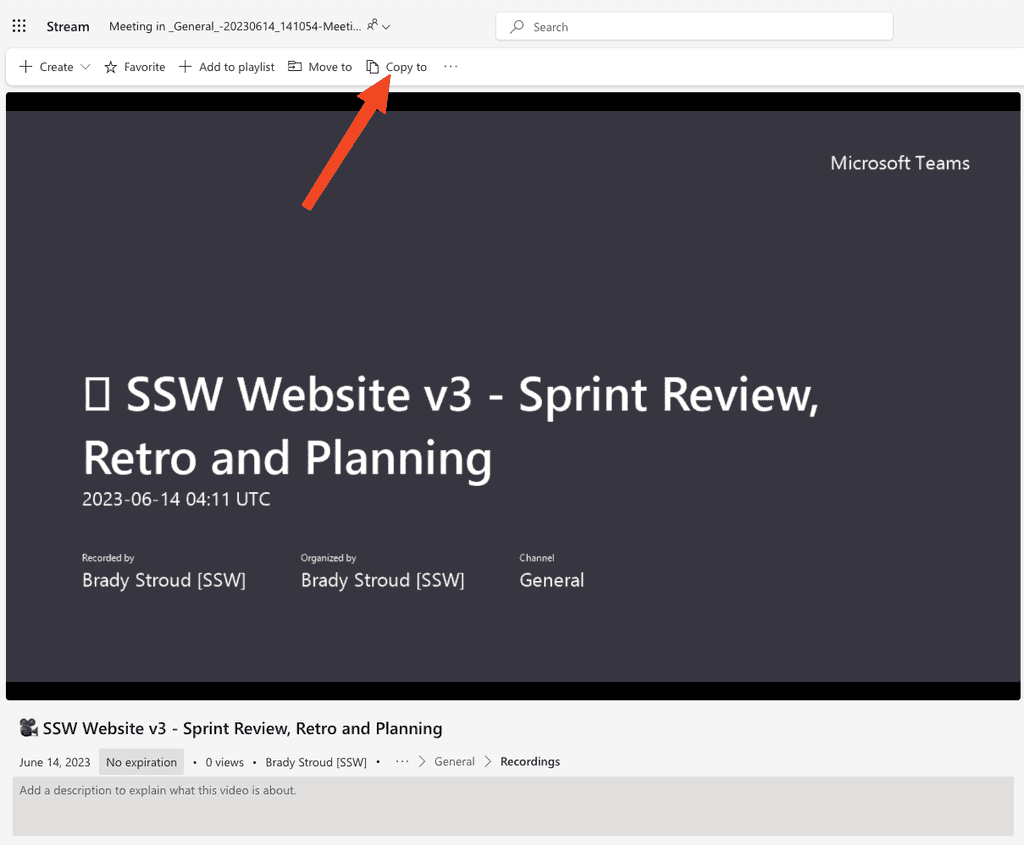
Figure: Click 'Copy to' - Move the recording to a relevant Team's channel
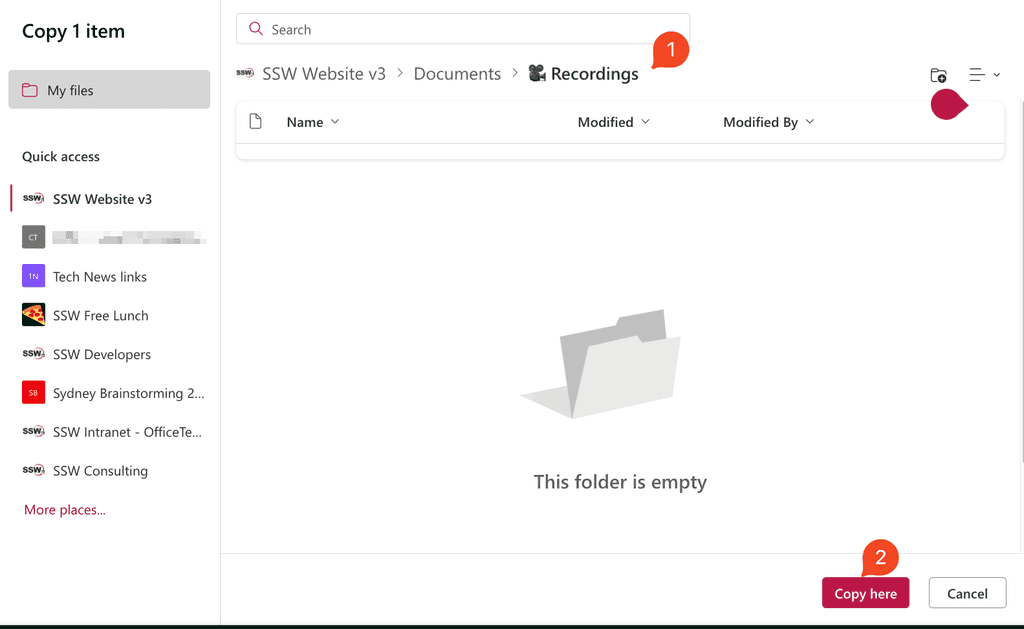
Figure: Move recording to a better - If you are going to share the video, upload it to YouTube and send the link
